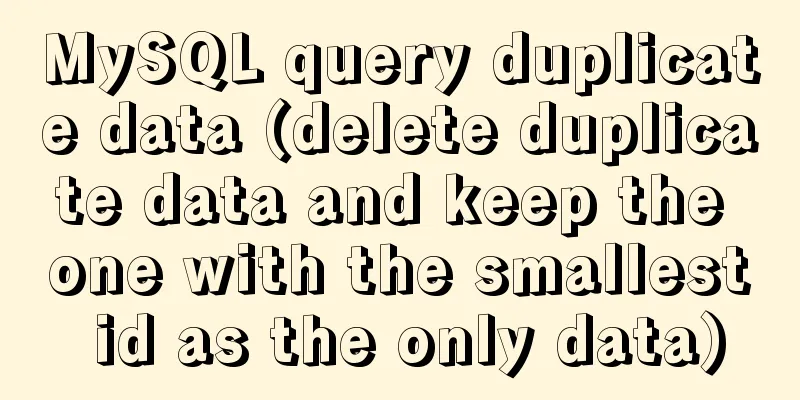A simple explanation of MySQL parallel replication

|
1. Background of Parallel Replication First of all, why is there this concept of parallel replication? 1. DBAs should know that MySQL replication is based on binlog. 2. MySQL replication consists of two parts, IO thread and SQL thread. 3. The IO thread is mainly used to pull the binlog passed by the receiving Master and write it to the relay log 4. The SQL thread is mainly responsible for parsing the relay log and applying it to the slave 5. In any case, the IO and SQL threads are single-threaded, while the master is multi-threaded, so there will inevitably be delays. In order to solve this problem, multi-threading came into being. 6. IO multithreading? 6.1 There is no need for multithreading of IO, because IO threads are not the bottleneck. 7. SQL multithreading? 7.1 Yes, the latest 5.6, 5.7, and 8.0 all implement multi-threading on the SQL thread to improve the concurrency of the slave. Next, let’s take a look at MySQL’s efforts and achievements in parallel replication. II. Key Points Whether it can be done in parallel depends on whether there are lock conflicts between multiple transactions. This is the key. The following parallel replication principle is to see how to avoid lock conflicts MySQL 5.6 schema-based parallel replication
As mentioned before, the purpose of parallel replication is to make the slave run as multi-threaded as possible. Of course, multi-threading based on the library level is also a way (transactions in different libraries, no lock conflicts) Let's talk about the advantages first: It is relatively simple to implement and easy to use for users. Then let's talk about the disadvantages: Because it is based on the library, the granularity of parallelism is very coarse. Now the architecture of many companies is one library and one instance. For such an architecture, 5.6 parallel replication is powerless. Of course, there is also the order of master and slave transactions, which is also a big problem for 5.6 Without further ado, here are some pictures
4. MySQL 5.7 Parallel replication based on group commit
Group commit is described in detail in previous articles and will not be explained here. When MySQL5.7 commits a group, it also marks the transactions of each group. Now I think it is for the convenience of MTS. Let's look at a set of binlogs first last_committed=0 sequence_number=1 last_committed=1 sequence_number=2 last_committed=2 sequence_number=3 last_committed=3 sequence_number=4 last_committed=4 sequence_number=5 last_committed=4 sequence_number=6 last_committed=4 sequence_number=7 last_committed=6 sequence_number=8 last_committed=6 sequence_number=9 last_committed=9 sequence_number=10 4.1 Commit-Parent-Based Mode
4.2 Lock-Based Mode
5. MySQL 8.0 parallel replication based on write-set
Transaction dependency:
Transaction detection algorithm: MySQL will have a variable to store the HASH value of the submitted transaction. The values of the primary key (or unique key) modified by all submitted transactions will be compared with the set of that variable after hashing to determine whether the modified row conflicts with it, and thus determine the dependency relationship. The variable mentioned here can be set in size by: binlog_transaction_dependency_history_size This granularity is at the row level. At this time, the parallel granularity is finer and the parallel speed is faster. In some cases, it is not an exaggeration to say that the parallelism of the slave exceeds that of the master (the master is a single-threaded write, and the slave can also play back in parallel) 6. How to make the slave's parallel replication and the master's transaction execution order consistent? After 5.7.19, you can set Official explanation:
The general implementation principle is: the excecution phase can be executed in parallel, and the binlog flush is performed in sequence. When the engine layer commits, it is also completed in the queue order according to binlog_order_commit In other words, if this parameter is set, the slave will parallelize as the master does. Summarize The above is the full content of this article. I hope that the content of this article will have certain reference learning value for your study or work. If you have any questions, you can leave a message to communicate. Thank you for your support for 123WORDPRESS.COM. You may also be interested in:
|
<<: 30 minutes to give you a comprehensive understanding of React Hooks
>>: Tomcat components illustrate the architectural evolution of a web server
Recommend
Detailed explanation of the configuration method of MySQL master-slave replication read-write separation
1. Description Earlier we talked about the instal...
Solutions to problems related to software package dependency reporting during installation in Linux
Table of contents background 1) Enable the keepch...
Axios project with 77.9K GitHub repository: What are the things worth learning?
Table of contents Preface 1. Introduction to Axio...
Vue3.0 project construction and usage process
Table of contents 1. Project construction 2: Dire...
How to configure VMware virtual machine NAT mode
This article describes the VMware virtual machine...
How to solve the problem of forgetting the root password of Mysql on Mac
I haven't used mysql on my computer for a lon...
Example of converting timestamp to Date in MySQL
Preface I encountered a situation at work: In the...
Hbase installation and configuration tutorial under Linux
Table of contents Hbase installation and configur...
MySQL Learning: Three Paradigms for Beginners
Table of contents 1. Paradigm foundation 1.1 The ...
Understand the use of CSS3's all attribute
1. Compatibility As shown below: The compatibilit...
Web page experience: planning and design
1. Clarify the design direction <br />First,...
MySQL view principles and basic operation examples
This article uses examples to illustrate the prin...
Table Tag (table) In-depth
<br />Table is a tag that has been used by e...
Example code for using HTML ul and li tags to display images
Copy the following code to the code area of Drea...
A link refresh page and js refresh page usage examples
1. How to use the link: Copy code The code is as f...












